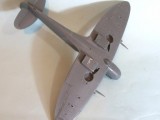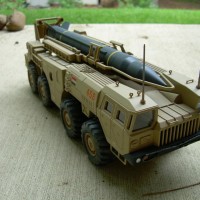Eduard 1/48 Spitfire IXc (early)
Had not the RAF been able to bring a new Spitfire into combat in the summer of 1942 to face the Fw-190A that could outfly the Spitfire V on every point but turning circle, the war over Northern Europe would have likely taken a different course.
As it was, the RAF had to stop daylight operations over northern France twice - in November -December 1941 and in March-April 1942 - due to high losses of Spitfires operating against JG 2 and JG 26 on the Channel Front. The new Merlin 61-powered Spitfire VII and VIII with their 2-stage superchargers could match the Fw-190's performance, but were at least a year away from production.
As a "stopgap," two Spitfire Vc airframes, AB196 and AB197, were given strengthened longerons and Merlin 61s with 2-stage superchargers were mounted. AB196 first flew on February 26, with AB197 taking to the air a month later. Both were successful and on the strength of these results the Spitfire IX was ordered into production at Castle Bromwich immediately.
Even given top priority, the Spitfire IX did not fully equip all RAF fighter squadrons in the UK until late 1943. The "interim" Mk.IX became the second most-produced Spitfire, running close behind the Spitfire V, itself an "interim" engine upgrade of the Spitfire I, and gave the RAF parity with the best German equipment. As leading Spitfire IX ace Johnny Johnson noted in his autobiography, "Wing Leader," the Spitfire IX and the Fw-190A were so closely-similar in performance that the outcome of a fight was a matter of pilot ability.
Wing Commander Colin F. Gray, the New Zealand Ace of Ace:
Colin F. Gray and his twin brother Ken were born in Christchurch, New Zealand on November 9, 1914, the sons of an electrical engineer and his wife. In 1937, the brothers attempted to join the RAF. Ken was accepted, but Colin failed for medical reasons. A second try the next year also resulted in failure on medical grounds. To improve his fitness, Gray took up sheep mustering and was successful on a third application to join the RAF. Granted a short-term commission at the beginning of 1939, he underwent primary flight training at the de Havilland flying school at Hatfield, after which he graduated from Number 11 Flying Training School in October 1939.
Gray was posted to 54 Squadron, flying Spitfires from Hornchurch, in November 1939. During the Phoney War he took part in patrols over the English Channel until May 1940. The death of his brother Ken in a flying accident on May 1, 1940, hit him hard. With the German offensive on the Western Front coming on May 10, Gray entered combat over Dunkirk on May 24, 1940, claiming two probables. He was awarded a half victory over a Bf-109 the next day while escorting Swordfish to attack Gravelines. His Spitfire was badly damaged in the fight; damage to the port aileron forced him into a dive he was only able to pull out of with great difficulty. Despite this, he managed to force land sat Hornchurch.
Gray scored his second victory, another Bf-109, on July 13, near Calais after a long chase at sea level, killing the pilot, Leutnant Hans-Joachim Lange of III/JG 51. On July 24, he shot down Staffelkapitän Lothar Ehrlich of 8./JG 52. It is possible his victim was Leutnant Schauff from III./JG 26. On August 15, he was awarded the DFC. On August 16, he claimed two Bf 109s destroyed. On August 24, his flight was attacked by elements of I./JG 54 near Manston and he shot down Oberleutnant Heinrich Held. On August 31, he downed Oberleutnant Karl Westerhof from 6./JG 3. By early September Gray had 14.5 victories; 54 Squadron was sent north to rest and re-equip.
Promoted to Flying Officer on October 23, 1940, Gray served with 43 Squadron before returning to 54 Squadron in early 1941. Posted to 1 Squadron that spring, he was promoted to Flight Lieutenant in August. In September he was promoted to Squadron Leader and posted to command 616 Squadron until February 1942, when he was taken off operations and given a staff position with 9 Group.
Gray returned to operations in September 1942, as commander of 64 Squadron, the first unit to equip with the new Spitfire IX. That December, he was posted to 333 Group in the Mediterranean Theatre, taking command of 81 Squadron in Algeria in January 1943 when 81 became the first unit to fly the Spitfire IX in the Middle East. Between then and the end of May, he shot down eight aircraft bring his personal score to 22. He was awarded the Distinguished Service Order for this service.
Promoted to Wing Commander on June 1, 1943, he assumed leadership of 322 Wing, which was based in Malta where the unit conducted patrols over the Italian coast and supported the invasion of Sicily, during which time he shot down five more aircraft, scoring his final victories on July 25, 1943, when he shot down two Ju 52 transports. In September he was taken off operations and returned to England.
In August 1944, Gray was appointed Wing Commander of the Lympne Wing, flying the Spitfire XIV over France and occupied Holland. He did not score during this assignment, and finished the war with 27 victories, two shared destroyed, six probables and four shared probables. With this, Colin F. Gray became the New Zealand Ace of Aces. He retired from the RAF in 1961 and returned to New Zealand, where he died in 1995.
Eduard released the Spitfire IXc (late) in the Spring of 2013. The kit was quickly recognized as the most accurate Spitfire IX in 1/48 scale and is bettered only by the 1/32 Tamiya Spitfire IX kit. The new IXc (early) kit offers two sets of wings to allow the model to be built with either the early wide-chord cannon fairing or the later narrow chord fairing, with a choice of either the early small carburettor intake or the later Vokes universal intake. There is a choice of the early or late horizontal stabilizer and elevator, and the early or late rudder.
Like the earlier release, the kit offers a detailed cockpit and photoetch interior detail including an instrument panel and seat belts. Alternatively, one can use a plastic instrument panel with a decal. The surface detail includes riveting that is so petite it actually works in this scale. Decals are provided for five different aircraft, including the Spitfire IX flown by Squadron Leader Stanislaw Skalski of the Polish Fighting Team in Algeria in 1943, and a Spitfire IX flown on reverse Lend-Lease in the 31st Fighter Group the same year.
There are a large number of other aftermarket decals available for the early Spitfire IXc, most of which are no out of production, though available from some online distributors or on eBay. Victory Productions Decals has re-released the magnificent VPD48006, "Spitfire: Aces of the Empire" sheet first released in 2001 (which I had a part in developing). The Sky-colored codes have been re-done to match the more accurate Sky color done by Xtracolour/Xtracrylix. This is easily the best Spitfire sheet ever done, with markings of well-known pilots for all versions used in combat.
I said in my earlier review that the kit is a bit overly-fiddly, particularly with regard to the multi-part wheel wells and the method of attaching the exhausts. This is still the case, but once one has built one of these, doing further models is a breeze. Fit is so good that no putty or filler is necessary, and I had this model assembled in a few hours over the course of one day.
I decided to do Colin Gray's Spitfire IXc he flew while leading 322 Wing in the summer of 1943. I used Xtracrylix "Azure Blue," "Dark Earth" and "Middle Stone," applied freehand with my Paasche-H. I used the kit decals for the stenciling, and the Victory Productions VPD48006 sheet to create Gray's Spitfire, including the national insignia.
I gave the model an overall coat of Xtracrylix Flat varnish, then "dinged" it with a Prismacolor silver pencil, and finished off with Tamiya "Smoke" for the exhaust stains and oil stains on the underside center section.

















nicely done tom...great colors too
Love the history and love the model…well done as usual Tom.
Love this color scheme on the Spitfire, you did a fine job of it Tom.
Great job there Tom.
A lovely history lesson as well.
It is nice to hear these stories, it gives more of an insight behind things.
Well done Tom.
Looks great, Tom, and a fine bit of research.
Can't seem to enlarge the photos-hope it's just me.
it was just me...
Very nice Tom, always loved the desert scheme
I want to be Tom Cleaver when I grow up!
Lovely build Tom- as usual. Great historic background to your subjects- something that is very important to me in my modeling and something that gives depth to a build.
Thanks for building and always providing very useful overviews and reviews!
Dan from Bermuda.
Yet another beautiful Spitfire.
Thanks for the history and the pics! That's a great looking Spit.
Tom,
Very interesting history of plane and man. The review of the Eduard Spit is good and will serve me well if and when I do 1/48 Spitfire MK IX. Another of your fine builds on this model
Well done Tom, on another beautiful Spitfire. Is there such a thing as an ugly one? It was well storied and reviewed also. Only matched by my (our) appreciation for it.
Looks great in those colors Tom. Hard to resist a Spitfire. Haven't seen this kit version in the shops yet in Australia. Hopefully won't be too long. Very nice build indeed.
Nice clean build, as always, Tom. Great narrative to help us appreciate the prototype's lineage.
Nice job and funny that I was looking at that sheet today in my stash.